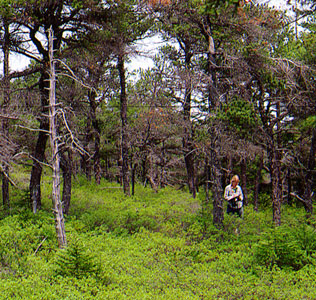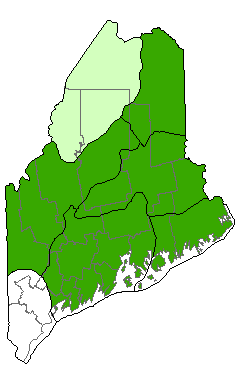DACF Home → Bureaus & Programs → Maine Natural Areas Program → Communities, Plants, and Animals → Natural Community Fact Sheets → Jack Pine Woodland
Printer Friendly Fact Sheet - 970 KB pdf (Get a free copy of Adobe Acrobat Reader)
Jack Pine Woodland
Scientific Name: Jack Pine Woodland; State Rank: S3

- Community Description
- Soil and Site Characteristics
- Diagnostics
- Similar Types
- Conservation, Wildlife and Management Considerations
- Distribution
- Characteristic Plants
- Associated Rare Plants
- Associated Rare Animals
- Examples on Conservation Lands You Can Visit
Community Description: These are open canopy woodlands (<60% closure) in which the dominant tree is always jack pine. Red spruce, black spruce, or white pine are common associates. The canopy trees are generally stunted and have poor growth form. Below the canopy, smaller jack pines are common, with scattered shrubs. The extensive herb layer is mostly heath shrubs that may form a thick tangle in canopy openings. At some maritime sites, black crowberry or mountain cranberry reflect the coastal influence. Herbs are very sparse. The bryoid layer varies from extensive to quite sparse, and is dominated by reindeer lichens. These are open canopy woodlands (<60% closure) in which the dominant tree is always jack pine. Red spruce, black spruce, or white pine are common associates. The canopy trees are generally stunted and have poor growth form. Below the canopy, smaller jack pines are common, with scattered shrubs. The extensive herb layer is mostly heath shrubs that may form a thick tangle in canopy openings. At some maritime sites, black crowberry or mountain cranberry reflect the coastal influence. Herbs are very sparse. The bryoid layer varies from extensive to quite sparse, and is dominated by reindeer lichens. Back to top.
Soil and Site Characteristics: Sites are dry and occur in cooler climate regions, on gentle slopes with very well drained flats, or on low ridges, usually at <900’ elevation. The substrate is a thin layer (<20 cm) of sandy soil or poorly decomposed organic duff over bedrock; some occurrences grow on deeper sands. Substrates are acidic (pH ~5.0) and nutrient poor. Most sites contain evidence of past fire, which in most cases is required to open the serotinous cones of jack pine. Back to top.
Diagnostics: Jack pine is dominant; canopy is generally less than 60% cover. Back to top.
Similar Types: Black Spruce Woodlands are floristically and structurally similar, with the exception of the dominant canopy species. Both types tend to occur in extremely nutrient poor and often coastal environments. Pitch Pine Woodlands occur in somewhat more temperate settings and are dominated by pitch pine. Jack Pine Forests have a closed canopy and much lower cover of heath shrubs and are known from only one area of western Maine. Back to top.
Conservation, Wildlife and Management Considerations: The coastal occurrences of this woodland type appear to be self maintaining and more or less stable in their extent. Perpetuation of the inland sites is probably dependent upon occasional fire or other disturbance. Natural fires in these woodlands may increase the ability of jack pine to maintain its dominance over potentially invasive or fire sensitive tree species. Several sites are on public lands or private conservation lands.
Jack pine woodlands may be inhabited by uncommon moths such as the western pine elfin, which uses jack pine as a larval host plant in the Midwest and more often black spruce in the east. Back to top.
Distribution: Immediate coastline of eastern Maine and lakeshores of north-central Maine (Laurentian Mixed Forest Province and New England - Adirondack Province), extending north, east, and west into Canada. Landscape Pattern: Small Patch, usually less than 40 acres, occasionally 100-200 acres. Back to top.


Characteristic Plants: These plants are frequently found in this community type. Those with an asterisk are often diagnostic of this community.
- Canopy
- Black spruce*
- Jack pine*
- Red spruce*
- Sapling/shrub
- Black chokeberry
- Black spruce*
- Jack pine
- Mountain holly*
- Dwarf Shrub
- Black huckleberry*
- Lowbush blueberry
- Mountain cranberry
- Sheep laurel*
- Herb
- Bunchberry
- Starflower
- Bryoid
- Reindeer lichen*
There are no documented rare plants associated with this natural community.
There are no documented rare animals associated with this natural community.
Examples on Conservation Lands You Can Visit
| Example | County |
|---|---|
| Cadillac Mountain, Acadia National Park | Hancock Co. |
| Great Wass Island Preserve | Washington Co. |
| Lake Umbagog National Wildlife Refuge | Oxford Co. |
| Petit Manan National Wildlife Refuge | Washington Co. |
| Schoodic Point, Acadia National Park | Hancock Co. |